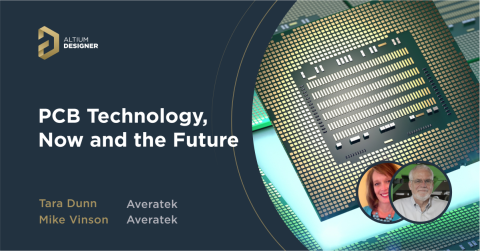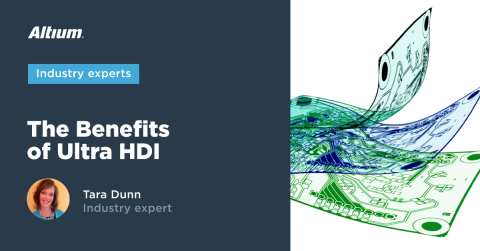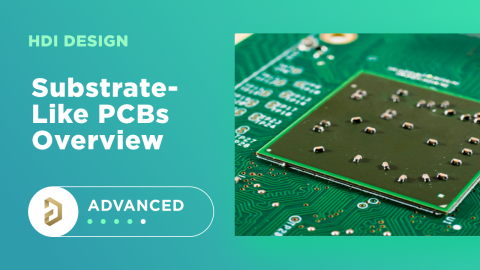Get to Know Microvia Manufacturing Processes and HDI Substrates

Initial HDI Fabrication
High Density Interconnect printed circuits actually started in 1980, when researchers started investigating ways to reduce the size of vias. The first innovator is not known, but some of the earliest pioneers include Larry Burgess of MicroPak Laboratories (developer of LaserVia), Dr. Charles Bauer at Tektronix (who produced photodielectric vias), [1] and Dr. Walter Schmidt at Contraves (who developed plasma-etched vias).
The first production build-up or sequential printed boards appeared in 1984, starting with the Hewlett-Packard laser-drilled FINSTRATE computer boards, followed in 1991 in Japan with Surface Laminar Circuits (SLC) [2] by IBM-YASU and in Switzerland with DYCOstrate [3] by Dyconex. Figure 1 shows one of those first Hewlett Packard FINSTRATE boards, on the cover of Hewlett-Packard Journal (1983).
HP Finstrate Laser-Via
HP did not intend to develop laser-drilled microvias. They were the result of reverse-engineering their new 32-bit microcomputer chip. They called it the “FOCUS” chip, a 32-bit microprocessor developed in NMOS-III, which has the characteristic of being very current-hungry. One of the early surprises with this new microprocessor was that it could not drive the inductance of a standard 0.3 mm dia. through-hole via in a 1.6 mm thick board. It could only drive 20-30 nHenrys of inductance, or a blind via of 0,125mm. The second surprise was that it did not have the energy to drive the normal losses of FR-4 (Dj=0.020), so pure polytetrafluoroethylene (PTFE) was used. The IC requirement for cooling required a metal-core board with very tiny blind-vias and a very low-loss dielectric. The resulting board created was a copper-core, build-up technology that had direct wire-bonded integrated circuits (ICs).
FIGURE 1. The first microvia PCB in general production. Hewlett Packard’s FINSTRATE was put into production in 1984. It was a copper-core, build-up technology with pure PTFE as a dielectric that had direct wire-bonded integrated circuits (ICs).
IBM SLC Photo-via
Since the introduction of IBM’s SLC technology in 1991, many variations of methods for mass-producing HDI wiring boards have been developed and implemented, judged in terms of volume produced, laser-drilling technology is the one. Other methods are still used by a number of PWB manufacturers, but on a much smaller scale.
However, a greater emphasis will be placed on the laser-drilling process (laser via hereafter) since it is the most popular process today and it seems that its popularity will grow in the future. It must be understood that via hole formation is just one element of fabricating HDI wiring boards. Fabrication of HDI wiring boards with microvia holes involves many processes not to conventional board fabrication.
HDI Fabrication Basics
Figure 2 shows the breakdown of Sequential Build-Up Technologies (SBU) or High Density Interconnects manufacturing process. The three basic elements are:
- Dielectric Format,
- Via Formation,
- Metallization Methods
FIGURE 2. Sequential build-up technology (HDI) has three major characteristics: Dielectric Format, Via Formation, and Metallization Methods (Courtesy of DuPont).
The manufacturing process for each microvia technology begins with a base core, which may be a simple double-sided board carrying power and ground planes or a multilayer board carrying some signal pattern in addition to power and ground planes. The core usually has plated through-holes (PTHs). These PTHs become BVHs. Such a core is often called an active core.
Dielectrics and Insulators
An overview of the dielectric and applied conductive materials used in microvia fabrication are covered in IPC-4104A standard. Some of these dielectrics can be used in both chip packaging and PWB HDI applications. Cross-references are made to the relevant material specifications of the IPC/JPCA-4104 specification for HDI and microvia materials
Material selection needs to answer these questions:
- Will the dielectric use chemistry compatible with current chemistry used by core substrate material?
- Will the dielectric have acceptable plated copper adhesion? (Many original equipment manufacturers [OEMs] want >6 lb./in. [1.08 kgm/cm] per 1 oz. [35.6 µm] copper.)
- Will the dielectric provide adequate and reliable dielectric spacing between metal layers?
- Will it meet thermal needs?
- Will the dielectric provide a desirable “high” Tg for wire bonding and rework?
- Will it survive thermal shock with multiple SBU layers (i.e., solder floats, accelerated thermal cycles, multiple reflows)?
- Will it have platable, reliable microvias (that is, will it have latitude to ensure good plating to the bottom of the via)?
There are nine different general dielectric materials used in HDI substrates. IPC slash sheets like IPC-4101B and IPC-4104A cover many of these, but many are not yet specified by IPC standards. The materials are:
- Photosensitive Liquid Dielectrics
- Photosensitive Dry Film Dielectrics
- Polyimide Flexible Film
- Thermally Cured Dry Films
- Thermally Cured Liquid Dielectric
- Resin Coated Copper Foil (RCC), dual-layer and reinforced
- Conventional FR-4 Cores and Prepregs
- New ‘spread-glass’ laser-drillable (LD) Prepregs
- Thermoplastics
Interconnect Via Formation
This section discusses processes that employ various drilling via-hole formation techniques. Through-via drilling is possible below 0.20 mm (0.008 in.), but cost and practicality discourage this. Below 0.20 mm (0.008 in.), laser and other via-formation processes are more cost-effective. There are many different methods of forming the IVHs used in HDI processes. Laser drilling is the most prominent. These different methods of via formation have some limits on the minimum size of the vias they form, as well a significant differences in rate of via formation.
FIGURE 3. Mechanically drilling the small vias by either controlled depth, Figure 3a, or sequential lamination, Figure 3b, is how HDI started in volume production.
Mechanical Drilling
The oldest technique for blind and buried via formation is mechanical drilling and sequential lamination, as seen in Figure 3a and 3b. Progress has been made in both small drill-bit manufacture and high-speed mechanical drilling to allow this technique to be used in some circumstances.
FIGURE 4. Creating the blind-via in a PWB panel is normally done with laser technology but ‘mass via processes’ like chemical etching, plasma or photodielectrics have also been used.
Laser Via Technology
Laser via processing is by far the most popular microvia hole formation process. But it is not the fastest via formation process. The chemical etching of small vias is the fastest, with an estimated rate of 8,000 to 12,000 vias per second. This is also true of plasma via formation and photovia formation (Figure 4). These are all mass-via-formation processes. Laser drilling is one of the oldest microvia generation techniques. [1] The wavelengths for laser energy are in the infrared and ultraviolet region. Laser drilling requires programming the beam fluence size and energy. High-fluence beams can cut metal and glass, whereas low-fluence beams cleanly remove organics but leave metals undamaged. A beam spot size as small as approximately 20 microns (<1 mil) is used for high-fluence beams and about 100 microns (4 mil) to 350 microns (14 mil) for low-fluence beams. [2] [3]
Most laser processes utilize either CO2 or UV lasers since they are the most readily available and economical lasers. When using a CO2 laser to produce vias in epoxy laminates, the copper must be removed above the area to be ablated (See Figure 5). The CO2 laser is primarily used for laminates not supported by glass. This includes unsupported laminates such as flexible polyimide and resin-coated copper (RCC®) foil and laminates reinforced with alternative materials such as aramid fibers. The modified TEA CO2 (Transversely Excited Atmospheric) lasers are specifically created to laze through glass fibers using 9,000 nm wavelength and higher peak power.
However, there are many variations. For the purpose of drilling microvia holes, there are five laser systems: UV/Eximer, UV/Yag laser, CO2 laser, Yag/ CO2, and CO2/ TCO2 combinations. There are also many dielectric materials: RCC, resin only (dry film or liquid resin), and reinforced prepreg. Therefore, the number of ways to make microvia holes by laser systems is driven by the permutation of five laser systems and these dielectric materials, as seen in Figure 5.
FIGURE 5. The three main laser blind-via ablation processes; c. lasing open the window in copper foil using UV or special treatments with CO2 lasers; d. Etching open a window in the copper foil and then lasing the dielectrics; e. Eximer lasing the via in materials and then metaling the dielectric with sputtering or electroless copper mSAP.
Higher power lasers (i.e. Ultra Violet-UV) can remove glass and copper and can therefore be used with conventional laminates, but are typically slower when going through copper and glass fibers. There are several factors to consider in laser via processing: position accuracy of lased holes (microvia holes), uneven diameters of holes, and dimensional change of the panel after curing dielectric, dimensional change of the panel due to temperature and humidity variations, alignment accuracy of the photo-exposure machine, unstable nature of negative artwork, and so on. These should be carefully monitored and are important for all microvia hole processes.
Method of Metallization
The last process is metallization of the vias. There are four different methods of metallizing the IVHs used in HDI processes. The methods are:
- Conventional Electroless and Electroplating Copper
- Conventional Conductive Graphite or other Polymers
- Fully and Semi-Additive Electroless Copper
- Conductive Pastes or Inks (Figs. 6f and 6g)
The laser is the most method of production of microvias to be filled with a conductive paste. Lasers are capable of ablating dielectric material and stopping when intercepting the copper circuitry, so they are ideally suited for creation of depth-controlled blind vias. Figure 6 shows these two major microvia processes.
FIGURE 6. Two of the most popular Asian processes for micro-via hole metalization is with conductive polymers; f. The BBiT process screens a conductive silver paste on copper foil and laminates it into the 2-sided core; g. Various conductive pastes are screened into laser-drilled holes in the b-stage dielectric and then laminated with copper foil into the core.
Watch and see how Altium Designer® supports HDI design:

Sign up and try Altium today.










